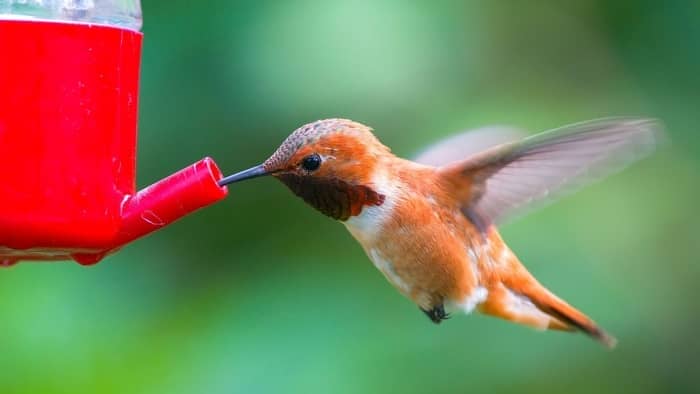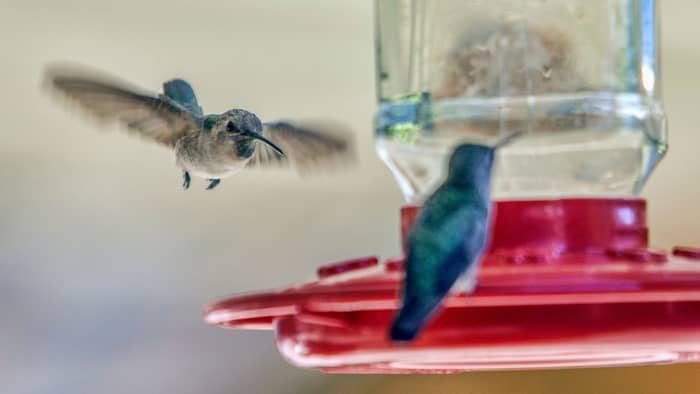Last Updated on August 6, 2022 by admins
When the intensely hot summer season begins, it’s understandable to want to know how this affects your hummingbird feeders. So once you’ve selected your hummingbird feeder, the question that may be on your mind is whether should you hang your feeder in the sun or shade?
As a hummingbird lover, it is paramount to maintain quality nectar for long so you can continue enjoying these radiant birds’ feed and hover around your yard. This is why you should position your hummingbird feeders in the appropriate place, especially during hot seasons.
So let’s discover if it’s right to position your hummingbird feeder in the sun or the shade.
Where To Hang Hummingbird Feeder Sun Or Shade
Maintaining a cool hummingbird feeder during the hot summer days can be very demanding. Exposing hummingbird feeders to the sun all day can cause the nectar to go bad quickly. This feeder tends to degrade or lose its quality when continually exposed to direct sunlight or temperatures above 90 degrees Fahrenheit.
Therefore, it is wise for you to place your feeder in the shade. You can position your feeders in shaded areas such as under a tree, walls, or eaves. Also, it is important to put in extra measures to maintain cool refreshing nectar for your hummingbirds.
So let’s find out ways we can maintain a cool feeder, especially during the hot seasons.
Maintaining Hummingbird Feeder Cool During Summer
Even though keeping these feeders cool on hot summer days may be challenging, we can still discover ways of maintaining that cool and refreshing nectar.
Maintaining a cool hummingbird feeder is to prevent the growth of deadly bacteria and fungi. Toxins which are quite deadly can contaminate sugar solution rapidly especially when warm. This can happen within 24 hours of the feeder solution receiving direct sunlight.
This can put your hummingbirds at risk of becoming ill thereby exposing them to possible predation. They may even die from feeding on unclean or unkept feeders.
So, below are some tips you can follow to achieve cool nectar during summer:
1. Keep feeders in shaded areas: Hummingbird Feeder Sun Or Shade
One appropriate way of maintaining that cool feeding nectar solution is to place them in a shaded environment. Avoid placing them under direct sunlight as much as possible. Hang the feeders under tree canopies, in a shaded umbrella, under an eave of a house, and so on.
However, if direct sun exposure is unavoidable, position your hummingbird feeder on the north or eastern side of trees or structures.
2. Use glass feeders
We encourage you to use glass feeders if the temperature in your region tends to reach 90 degrees Fahrenheit and above. Glass will provide a thicker blockage from surrounding temperatures and reduce nectar from becoming too hot.
3. Nectar reserve rotation
You will need to prepare a large amount of nectar solution to rotate homemade nectar. This will provide easy nectar rotation as you can store the excess nectar solution in the refrigerator and replace them frequently as required.
You can as well obtain the number of feeders you hang outside and keep in your refrigerator. This way, there is enough nectar solution for you to easily swap frequently on hot weather days.
4. Frozen ice cubes
If nectar reserve rotation is not so easy on you and time-consuming, you can simply add some ice cubes into your nectar solution.
If you are doing this, ensure you reduce the water you will be dissolving in the nectar recipe because of the ice cube you will be adding. You can use 3 and a half or 3 and a quarter cups of water instead of 4 cups dissolved in 1 cup of granulated sugar. This is to ensure the nectar doesn’t become too diluted for hummingbirds.
This way, the concentration of the mixture will be back to a 1:4 ratio after plain water ice cubes have been added.
5. Wrap hummingbird feeders in aluminum foil
Aluminum foil is reflective and nontransparent. So you can simply wrap or cover the feeder nectar portion with aluminum foil. Aluminum foil will reflect about 97% of heat and light. It will also block ultraviolet rays that may come in contact with the hummingbird feeder.
Can Hummingbird Nectar Get Too Hot
Hummingbird nectar can definitely get hot. But you don’t have to worry too much because hummingbirds aren’t delicate or fragile creatures. They can tolerate hot nectar just as human beings can drink and tolerate hot coffee.
So far the nectar solution isn’t too hot to burn or hurt human skin, then it won’t hurt the hummingbird tongue. But you can put in extra measures to maintain cool refreshing nectar for your sweet birds.
Whenever the weather is hot, we recommend you change your feeder solution every two days. But when the weather is milder, you can replace them once a week.
Does Hummingbird Nectar Go Bad
Certainly, nectar solution does go bad. This is why you need to take some steps to keep them fresh and healthy always.
For instance, if you have bigger quantities of nectar solution, you can store up leftover nectar for up to 7 to 10 days. Then when it’s time, dispose of the old nectar and replace the solution with the stored fresh nectar solution.
Always make it a habit to replace nectar solutions at the appropriate time according to how the weather changes in your region.
Conclusion On Hummingbird Feeder Sun Or Shade
We have concluded that placing hummingbird feeder under the direct sun is bad but you should rather place them in the shade. You can hang them under a canopy tree, use a shaded umbrella, hang them under the eaves of a house, and so on. But always ensure the feeding solution does not go beyond 90 degrees Fahrenheit.
Hummingbirds can tolerate heat if they are provided with adequate water. This is why it’s important to provide them with cool and fresh nectar solutions as well as some shelter away from the sun.
Always replace the feeding solution every two days during hot summer days and follow our tips on how to maintain a cool nectar solution.
Read more about Why Aren’t Hummingbirds Coming To My Feeder.

Eunice is a passionate lover of hummingbirds and all things nature. She loves to observe and study the tiny birds, learning about their unique behaviors and unique features. She has written a number of articles about hummingbirds and their habitats, which have been featured in a variety of publications. In her spare time, she enjoys visiting hummingbird sanctuaries and going on bird–watching trips in her local area. She also volunteers with local wildlife rescue organizations, helping to rehabilitate injured birds. When she’s not outdoors, Eunice can be found writing articles, creating bird–inspired art, and playing the flute.



